
34 minute read
On Set
John Holosko csc
What films or other works of art have made the biggest impression on you?
Braveheart, Blade Runner, Shine a Light, Gangs of New York, The Last Emperor, Lock, Stock and Two Smoking Barrels. Works of art: by far, the Dutch masters in the Louvre.
How did you get started in the business?
After completing my second year of cinematography at Humber, I took a PA job for the summer at Scollard Productions, and voilà, I was in the business. A year later, I took the CSC Camera Assistant Course. Trained with Hans at William F. White, and Helmut at Panavision. DP’ed my first feature in 1991, Vita da cane.
Who have been your mentors or teachers?
My teachers at Humber – George Falada, Ludwik Dietrick. My mentors – Fritz Spiess csc, Gerd Kurtz, Derek Vanlint csc, Brian Mindel, Vilmos Zsigmond asc, hsc, Alex Thompson bsc.
What cinematographers inspire you?
Vittorio Storaro asc, aic; Janusz Kaminski asc; Daniel Mindel asc, bsc, sasc; Michael Ballhaus asc; Kazuo Miyagawa, Matthew Libatique asc; Dion Beebe acs, asc; Frederick Elmes asc; Darius Khondji asc afc, and all of my mentors.
Name some of your professional highlights.
While I was shooting aerials and other footage on a Milwaukee beer commercial for Vilmos Zsigmond, rain delayed us in the afternoon, and we sat in a coffeeshop in Niagara Falls talking film for three hours. Then the next day at dailies after we watched my footage, he stood up, shook my hand and thanked me for matching his cinematography perfectly; we became friends. Working at Schultz Productions. Being asked to submit my work and receiving full CSC accreditation in 1992. Being so fortunate to be around so many talented cinematographers, directors and travel the world.
What is one of your most memorable moments on set?
Meeting my wife, the love of my life.
What do you like best about what you do?
Interpreting a story, creating the director’s vision and evoking the emotional arc with light. Doing what I love, the art of being creative. Travelling the world, meeting and working with so many creative people. The integration of music and light in film.
What do you like least about what you do?
The time away from my family.

Courtesy of John Holosko csc.
What do you think has been the greatest invention (related to your craft)?
Great Macchina da caffè espresso machines. The adoption and integration of DMXed controlled lights allowing you to create any lighting your creativity can dream up. Digital camera’s sensitivity and exposure latitude allow you to recreate exactly what you desire. More pleasing aspect ratios. So many new and creative camera rigs to achieve shots we used to only dream of. Drones.
How can others follow your work?
My website, John Holosko.com/ca. My most recent feature Nursery Rhyme of a Madman is available on Vimeo.
CSC at 2020
CSC congratulates the following members whose films were selected for the 2020 Toronto International Film Festival.
TIFF DOCS Chris Romeike csc, Inconvenient Indian (dir. Michelle Latimer) Joshua Allen csc & Ian Kerr csc, The New Corporation: The Unfortunately Necessary Sequel (co-dirs. Jennifer Abbott & Joel Bakan) CONTEMPORARY WORLD CINEMA Tobie Marier-Robitaille csc, Night of the Kings (dir. Philippe Lacôte) MIDNIGHT MADNESS Adam Crosby, Violation (co-dirs. Madeleine Sims-Fewer & Dusty Mancinelli) SPECIAL EVENTS Maya Bankovic csc, Akilla’s Escape (dir. Charles Officer) Matthew J. Lloyd csc, asc, The Water Man (dir. David Oyelow) SHORT CUTS Peter Hadfield, Benjamin, Benny, Ben (dir. Paul Shkordoff) Cole Graham, Rules for Werewolves (dir. Jeremy Schaulin-Rioux) John Ker, Succor (dir. Hannah Cheesman)
Associate member Michael Jari Davidson meters a set up on a motion control commercial in Toronto with COVID measures in place.

Credit: Jonny Micay Pieter Stathis csc shooting daytime exteriors for the long-running Hallmark mystery series Aurora Teagarden.

Courtesy of Kevin Speckmaier

Cinematographer Mat Barkley associate member shooting Ontario Equestrian PSA “For The Herd.”
Credit: Kegan Sant

Camera Operator Kelly Mason associate member and dolly grip Jackson Wolfe shooting Supergirl on location in Vancouver.
Photo courtesy of Kelly Mason
Associate Member Christina Ienna working on a Big Pig Co production in Sudbury, ON.

Credit: Mark Delottinville

Sandrine Daoust (2nd AC/data wrangler B cam), Eric Morin (1st AC A cam), DP Serge Desrosiers csc (as Clown Patof), Jean-Sebastien Desrosiers (B cam operator), Patrick Biron (1st AC B cam), and Jennifer Pitoscia (2nd AC A cam) on the set of the feature film The Wolf and The Lion.
Credit: Emmanuel Guinet

Cinematographer and A camera operator David BercoviciArtieda associate member with longtime friend, collaborator and camera operator Christina Kasperczyk on the set of The College Admissions Scandal.

DP Maya Bankovic csc talking to director Charles Officer on the set of the feature film Akilla's Escape.
Credit: Amanda Matlovich
Men for All Seasons

Bows Out
By Trevor Hogg, Special to Canadian Cinematographer

First appearing in New Teen Titans #21 (1982), Vanessa Van Helsing has graduated from comic books to carrying on the family tradition of eradicating vampires on the small screen in an American-Canadian co-production that is airing its fifth and final season on Syfy. Neil LaBute (In the Company of Men) created Van Helsing and was subsequently replaced in Season Four by Jonathan Walker (Wu Assassins). Also changing over the course of the series have been the cinematographers, with Brendan Uegama csc (Child’s Play) being responsible for Seasons One and Two, associate member Ronald Richard (Dangerous Lies) shooting Season Three, Gerald Packer csc (Schitt’s Creek) lensing Season Four, and Neil Cervin csc (Arrow) taking charge of Season Five. “For the pilot, my research started with freshening up on the mythology of vampires and Van Helsing by re-watching some of the classics, such as Nosferatu and Dracula by Francis Ford Coppola,” Uegama explains. “I spent many hours gathering references and narrowed down hundreds of images for a look book that I presented to everyone. We tested a lot of things, such as blood, vampire makeup, and lighting them with firelight and sidelight. Since it was a post-apocalyptic world and there was no power in
Credit: Courtesy Nomadic Pictures

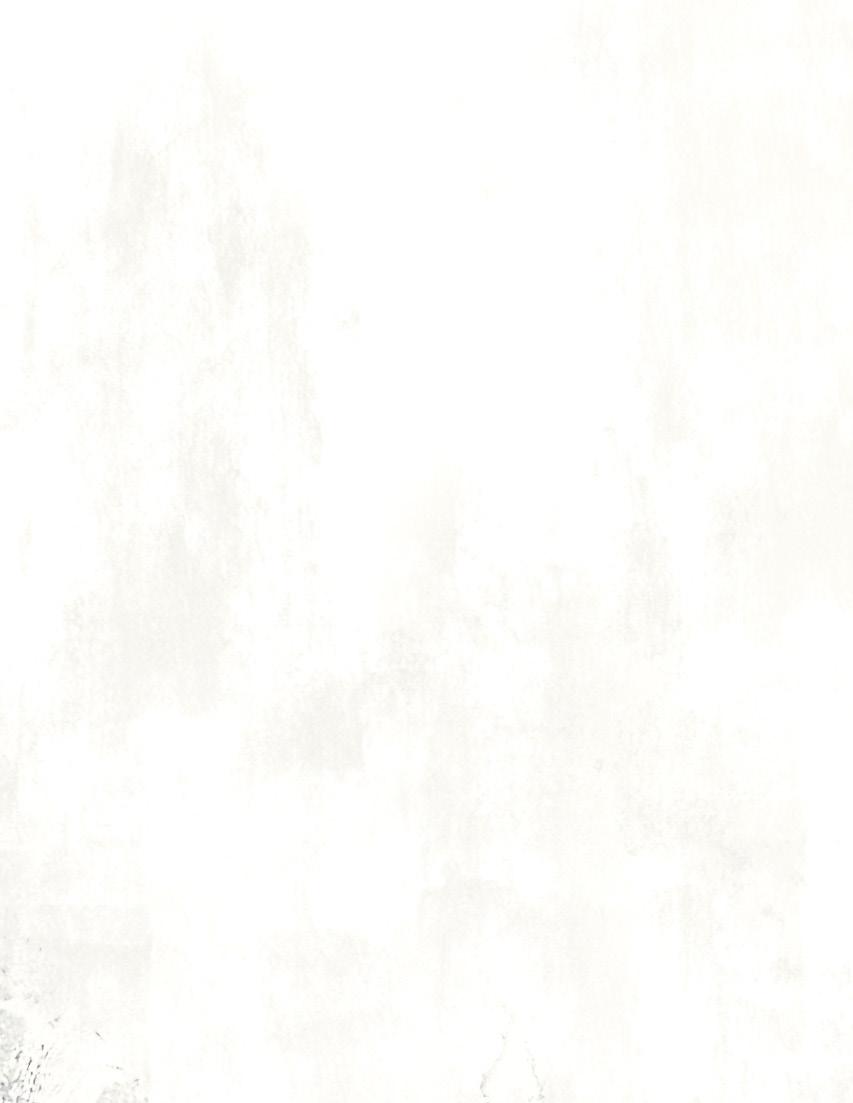
Kelly Overton as Vanessa Van Helsing in Van Helsing, Season 1.
the cities in our storyline, shooting night scenes in the city could not be accomplished at true night due to the thousands of city lights we would need to paint out. Day for night became our solution.” Four weeks were spent in prep with director Michael Nankin (Stargirl), while principal photography for the pilot lasted 21 days. “Michael and I decided to allow scenes to play out and not get into ‘traditional coverage’ if we could avoid it,” Uegama
states. “We talked about the characters’ emotional arc and if something was important to really highlight it, we would talk about how to do so.” The aspect ratio was 1.78:1, while footage was captured 5K and often with three cameras. Seasons One and Two were captured on RED DRAGON cameras with Ultra Prime lenses, according to Uegama. Production was based in Vancouver. “Our studio was the old Canada Post building located right downtown,” the DP says. “Production designer James Hazell [Siren] built most of our sets for the first half of the season there. Story-wise, the characters were living in an abandoned hospital in downtown Seattle. At the end of Episode 107, they need to escape the hospital, and we spend the remaining episodes of the season on the road.” A constant from the beginning of Van Helsing has been lead actress Kelly Overton, who was pregnant while shooting the second season. “Kelly is a rock star,” Uegama remarks. “She would come in and do her work day after day. Our typical approach was to shoot out her dialogue or any shots we would see her face, then let her go, and clean up the scenes with her double. On a visual side, we had to try and be as conscious as possible at hiding her belly. Wardrobe helped the best they could by dressing her in black with a partial cloak that would help hide from side angles.” Blood, gore and violence are natural extensions of the subject matter. “We wanted to make sure the blood read on screen, but we wanted to keep it darker when used on vampires and redder when it came from humans,” Uegama says. “We also decided in prep that we wouldn’t use squibs for any gunshots. We knew right away that would always be done with visual effects. But when it came to blood on an actor or on the ground, we used a lot of it! As
(L-R) Camera operator Glen Dickson, Brendan Uegama csc, and director Kaare Andrews.

Credit: Daniel Power

for the gore and violence, the network wanted it to be gory.” Using the visual language established by Uegama as a guide, Richard took over for Season Three. “I knew Brendan from shooting second unit on Riverdale and talked to him about the process for Van Helsing,” Richard recalls. “Neil LaBute loves doing things that he hasn’t done before, which opened a giant sandbox for me as a DP. I told him what I liked and would do differently. I wanted to have long takes and lots of camera movement accelerating the story forward. I do a lot of gimbal on a pipe where you treat it like a Technocrane that can go anywhere except vertically. We would elaborate and create these long shots. Neil liked that approach. We were in a doctor’s office set and I remember looking through an orange needle tray with the camera to see what that would look like. Neil loved it and said, ‘Let’s make a filter out of that piece of plastic.’ He wanted it burned in.” Six days of principal photography were devoted to each episode. “There was no alternating DP, so a lot of it was based on instinct because you would only get to prep ahead so far,” Richard says. “Your gaffer and key grip would come back, and the production
Credit: Courtesy Nomadic Pictures
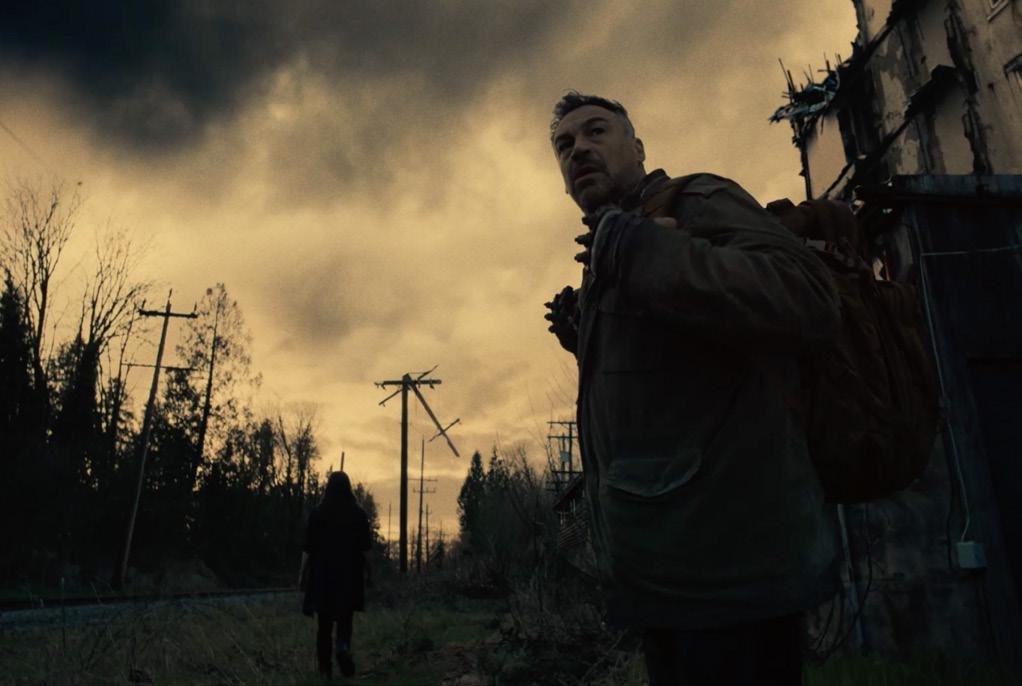

Aleks Paunovic as Julius in Van Helsing, Season 2
designer would show you a couple of photos. You would have to come up with a plan for what you’re going to do in three days when you go and shoot there without ever seeing the location.” Shooting blocks were determined by locations rather than episodic order. “The show was literally 90 per cent location shooting, and they would augment by putting in or changing a wall. It was hard because you’re limited by where the windows are, and you can’t pop in a ceiling. The production designer [Grant Pearse] made sure that I had options,” Richard offers. A big change in Season Three was the emergence of Daywalkers, which meant that the series was no longer confined to nighttime settings. “It opened the door for us to embrace sunlight,” Richard eplains. “Shooting outdoors was faster as I didn’t have to set up a bunch of stuff. You position things according to the sun; that was the hardest part with some directors as the sun would be in the wrong spot for the blocking that they had in mind.” The footage was captured with the ALEXA Mini camera and ARRI Master Primes lenses. “I wanted to shoot with a lower light and shallow depth of field, so I upgraded to the Master Primes,” he explains. “It has the same look as the Ultra Primes, but you can shoot a lot faster. We used wide lenses for 80 per cent of the show.” Problems were solved by creative solutions. “It stimulates you in a way that is enjoyable. Van Helsing embraced the risk because the potential reward was greater than playing the safe way.”
Replacing Richard for Season Four was Packer, who got to work with new showrunner Jonathan Walker. “Jonathan wanted to change things up a lot. It was a whole new crew; he and [executive producer] Mi- chael Frislev wanted more camera movement and more fights hand- held,” Packer recalls. “Just more im- mediate frenetic stuff. We followed lighting and certain things, like the last episode of Season Three was a cliffhanger where they are fighting in a mausoleum, and Episode 401 picks up in the middle of that fight.” A significant story decision was made with the focus shifting to- wards the children of Vanessa Van Helsing hunting vampires, he adds. “There is a lot of license for what you can do once you start changing the story. However, you don’t want to change everything when you have three seasons of fans.” Lighting is essential in retaining a consistent look going from director to director. “A lot of directors are going to have their own ideas about how they want to cover a scene,” Packer observes. “You have a time limit, so you try to do it as eco- nomically as possible.” There was a balance shift in favour of studio shooting with the production be- ing based in Surrey, B.C. “I used an ALEXA Mini and had a set of Leica Summilux lenses. We used a Ronin on a crane, dolly and handheld or on a SlingShot rig,” he says. “When using the Ronin, you have to rebal- ance it every time you put a new lens on. But you can pop Simmi- lux lenses off in moments without adjusting. The camera was always moving. I wanted to get some nice staccato images. We tried to get a
Top: Van Helsing, Season 3. Middle: Julie Lynn Mortensen as Lily Van Helsing in Season 3. Bottom: (L-R) Ronald Richard with director, Jason Priestley on the set of Van Helsing, Season 3.




Credit: Courtesy Nomadic Pictures


Jonathan Scarfe as Axel Miller in Season 4.
lot of coverage for the action and worked with two cameras all of the time, plus a third for fights. I had a 29 mm right in there to get a closeup and moved the camera with the actors as they fought.” Fights are trademark of Van Helsing, with stunt visualization put together by the stunt department. “With stunts and fights you have to get the right angle so that the punches look like they’re actual punches not Batman and Robin stuff,” Packer notes. “What was great about the stunt guys is that they really understood where a punch did and didn’t work and knew where the camera should be.” Various methods were deployed to distinguish between the past, present and future. “For the past, I desaturated the colours, had more contrast and a different blue than was in the room. It was treated again in post. The director wanted to do the flashback episode in one take, so the 42-minute show is a series of seven one-ers. It added a whole level of tension. It makes you feel that you’re in the room with these girls getting chased by zombies.” Reflecting on Season Four, Packer adds, “The biggest challenge was getting the work done and the right amount of footage during the day. You had to keep moving forward.” After lensing episodes for Seasons Two, Three and Four, Cervin – who this summer won a Leo Award for Best Cinematography Dramatic Series for the Season Four episode “Miles and Miles” – was in the midst of shooting the fifth and final season when the COVID-19 pandemic shut down the production. “I shot Episodes 501, 502 and 503 in Slovakia before they closed that country down, and I got

Credit: Courtesy Nomadic Pictures


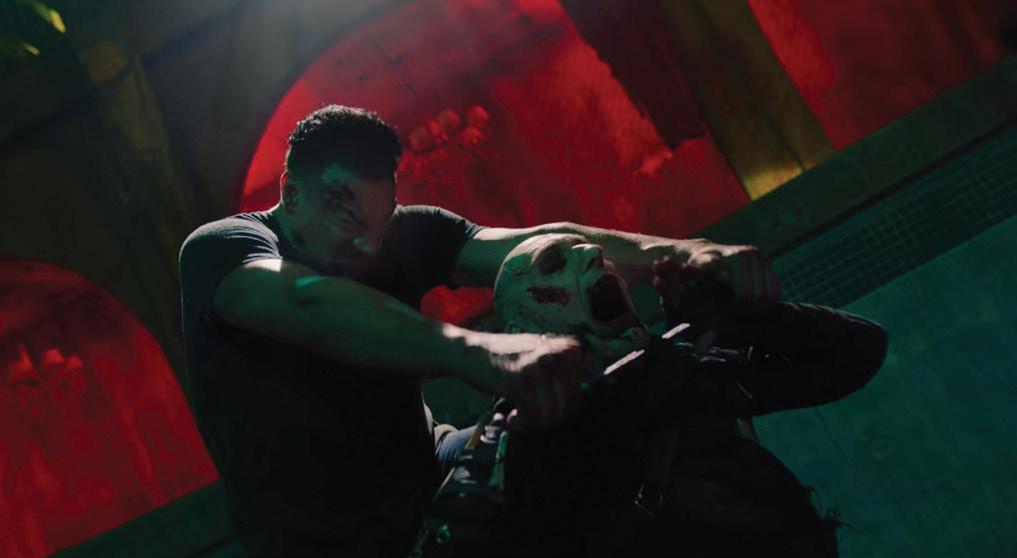
Top: Keeya King as Violet Van Helsing in Season 4. Middle: (L-R) Aleks Paunovic as Julius and Rowland Pidlubny as Scab in Season 4. Bottom: Gerald Packer csc (right) and a camera assistant on the set of Van Helsing, Season 4.
Credit: Courtesy Nomadic Pictures
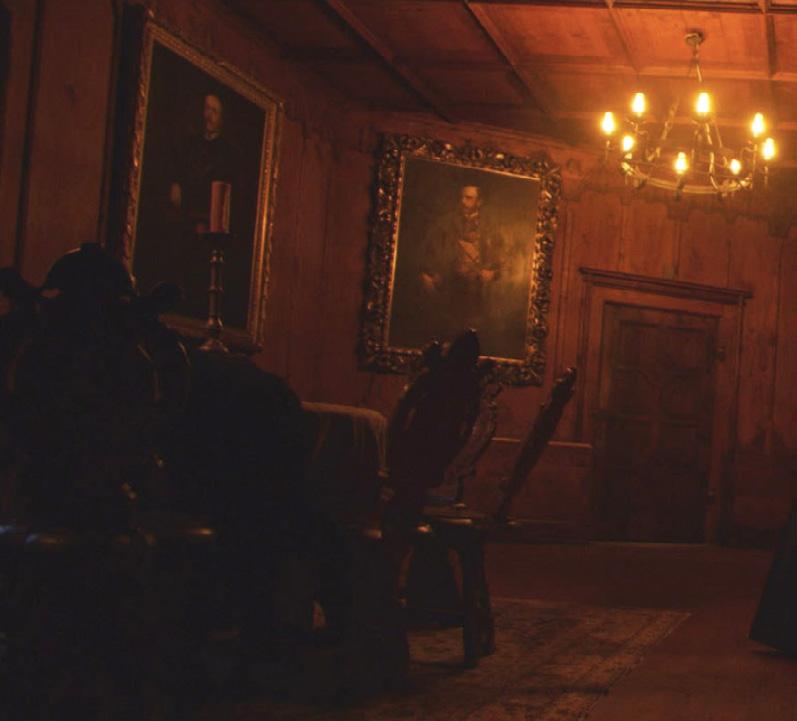
Neil Cervin csc
Tricia Helfer as Dracula in Van Helsing, Season 5.

involved with the Kamloops, B.C., shoot where we did episodes 505 and 506. Afterwards I got asked to do the rest of the show.” Often shots were combined, and the resolution went from 4K to 6K if a frame was going to be extracted later in postproduction. “There was one scene that we were doing in Kamloops last year where the sun was going in and out of clouds, so I had an 18K in line with the sun,” Cervin recalls. “It was the only way to keep it going and stay on schedule.” The camera package was altered for the principal photography in Slovakia as the scenes take place during the Middle Ages. “Most of it was going to be shot with candles and moonlight,” Cervin explains. “It’s a vampire show so there were going to be a lot of night shoots. I went for a camera that would give me 6K, which was the RED MONSTRO with a Helium sensor that actually does 8K and looks good in low light. I used Vantage lenses that are T1, which is amazing because normally lenses are T1.4. I got those for the big castle exteriors. When we were doing stuff in the castles I was going for wide lenses, 12 mm, 14 mm and 17 mm. These castles were the most amazing locations that I’ve ever been in my life.” Lighting needed to be augmented. “There are these fantastic lights made by Astera called Titan and Helios,” he says. “The Titan is a 4-foot tube and the Helios is a 2-foot tube; they throw out a bit of light, come with some light controls, you can put eight of the four-footers in one big soft light rig, which a guy can pick up with one hand, and both of them have internal batteries that can last for ages. The Astera tubes were nicer than actual candlelight flicker and are easy to rig.” Following the COVID-19 film production lockdown, the remaining episodes were set to be captured with a revamped camera system. “We are getting lovely images from the Sony FX9, but it’s not as production friendly as the VENICE,” Cervin states. “It does 6K but samples down to 4K. We’re shooting Super 35 all the way through.” The camera
One is an RGBW tube light, the other a powerful LED lineup that rivals the output of portable HMI lights – these portable production lighting solutions from NanLite put incredible power in your hands.
(L-R) Director Jonathan Scarfe and Neil Cervin csc on the set of Van Helsing, Season 5.


Credit: Courtesy Nomadic Pictures

Credit: Mayo Hirc
change will not be visually jarring as the rest of the season occurs in the future. “We’re also going to be using a Z CAM. It’s made in China and has 15 stops of latitude. It’s basically a 3-inch cube with a hole for a PL lens mount. We’re going to use that on a Ronin. It’s such a tiny camera that it can go anywhere; that’s 6K and is connected to a wireless.” Life on set has been impacted by the pandemic. “The crew is coping well with the COVID-19 protocols. Keeping safe distance when we can, always wearing face masks and lots of handwashing. We all know that it is in our best interest to shoot safely,” he says.
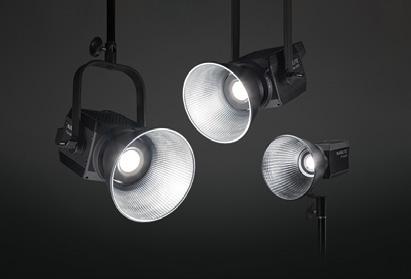
The Nanlite Forza LEDs pack a real punch and come in 60, 300 and 500 watt versions and have a wide range of lighting modifiers; each offers incredible output relative to its size: up to 6732L, 29440L and 46613L respectively.

Available in 10-inch, two-foot and four-foot versions, the Nanlite PavoTube RGBWW LED tube light features a convenient internal battery and adjustable colour temperature up to 7500K.
Both lineups boast a CRI of 98 and a TLCI of 95, 0 to 100% flicker-free dimming, plus a full slate of cool special lighting effects. Each model is designed to meet different needs: which ones belong in your production bag?
NANLITE FORZA & PAVOTUBE LIGHTS ARE AVAILABLE AT VISTEK
Letting in the Light: MICHAEL WYLAM Shoots WHERE DARKNESS LIES

By Fanen Chiahemen
Director Chino Saavedra’s short film Where Darkness Lies is a psychological fantasy drama in which the protagonist, Jamie ( Jesse Moss), is forced to contend with his troubled past, while taunted by a supernatural force in a log cabin. Shot at Virtue Studio
Ranch in Mission, B.C., with Sim Digital providing the camera package and William F. White and
Gearbase Camera Rentals providing lighting and grip packages, the film earned associate member
Michael Wylam a 2020 CSC Award nomination for
Dramatic Short Cinematography, a 2019 Australian
Cinematographers Society Gold Award, as well as a Leo Award nomination for Best Cinematography in a Short Drama earlier this year. Wylam tells Canadian Cinematographer about bringing the film to life.
Canadian Cinematographer: What kind of visual style did the script and the director call for?
Michael Wylam: The tone of the script required a lowkey look, grounded in reality but where the imagery blurred the line with fantasy. I knew instinctively that I wanted there to be contrasts to help show the conflict in Jamie. The interplay of light and dark, colour contrast and camera movement would all be

in conflict to show the deteriorating state of Jamie’s mind. I also wanted to play with subjective and objective perspectives, hugging the eye line, giving a sense of power to characters as needed and holding shots wherever possible for tension. The darkness was a great canvas to start on, and Chino was very generous in giving me the freedom and trust to punctuate this film with a visual grammar that would help drive the narrative.
CC: What influenced your choice of camera and lenses?
MW: The audience had to be on a journey with the protagonist, and as he is searching for clues, I wanted the audience to feel like they were searching for details with him. I paired Arri Master Primes with the ALEXA SXT at 3.2K, shooting at T2 1/3. This meant the audience could see the texture of the cabin enough, but it still very much gave us control of what to reveal and when with fast focus fall-off. I felt the sharpness of the Master Primes would allow the audience to feel as if they were hunting for details with Jamie. I knew I was mainly going to be on wider lenses for this project as we had chosen the location partly for the space it gave us, and some of the closeups needed the intimacy and immediacy of a wider lens. I wanted to throw those wide lenses in juxtaposition with key moments of claustrophobia
where I went longer and compressed the background, suffocating Jesse visually. I did use a digital diffusion filter on our female lead to create a little glamour to her introduction. The cabin was so large, and so much of the journey of the film was with Jamie that playing with negative space I knew would speak volumes visually. Shooting 2.35 spherical gave us the sense of isolation needed for story.
CC: Can you talk about transforming the horse stable into a set that you could light and shoot?
MW: The horse stable had character and depth to pull actors away from walls, and space for the dolly to not be encumbered. I loved the texture and dark browns of the log cabin, knowing they would suck up light and removing the need for negative fill on the deck, thus saving time and freeing up space for our actors. For the floorboards, I requested a darker, matte option that wouldn’t sheen and bounce our lights everywhere so I could control my ratios. I felt it was important to create layers within the cabin, which would help me with introducing washes of light with different qualities to articulate an omnipresence within the dark space. Even the direction of the floorboards I felt created a textural quality, knowing where our frames were likely to be. The wooden pillars would also allow for a dynamic energy at certain points informed by parallax movement moving through the space with our dolly moves. There were numerous gaps in the walls, which I had asked to be filled so the sun’s path wouldn’t interfere with the shooting day. The cabin also had stairs and an upper level, which served as a gantry running along all four sides. This meant we could easily rig lights high in the ceiling and hang silks and bounce as required, and much of our lighting came from overhead, which was made possible by drilling fixtures into beams high above the set. I also requested a small clearing be made along the outside of the cabin near the main window as I wanted to play with an idea for the climax of the film where Jamie reluctantly shoots his mentor, Sam. The magnitude of his actions I felt warranted a level of detachment visually, and having seen much of the film from Jamie’s perspective, and always within the cabin location, shooting the climax of this scene outside the cabin looking through the window gave a sense of depersonalization for Jamie.
CC: How did you approach the lighting setup in the cabin?
MW: There was a mixture of day and night scenes shooting through short winter days, so I made the decision early to tent out the doors and windows so we could shoot night interior scenes at any time of day, and day interior scenes in the mornings knowing that all the windows of the cabin were west facing. This helped maintain my lighting ratio and – knowing the crew was minimal – speed of setups was important. Key grip Chris Rogers was able to prerig this the day prior to shooting and his wealth of experience was essential to the smooth running of the set as was the efficiency and speed of gaffer Corey MacGregor on the day. The day scenes needed to have very separate looks. The opening scene required a heavy and almost sickly amber heaviness to it, as if the heaviness of Jamie’s actions weighed on him as we reveal the room on a dolly. In the end scene, scorching light surrounds the cabin from all directions, coming from gaps in the walls,
Actor Jesse Moss and DP Michael Wylam on the set of Where Darkness Lies.

Credit: Larry Wright
(L-R) Jesse Moss, Philip Granger, Michael Wylam and Chino Saavedra.
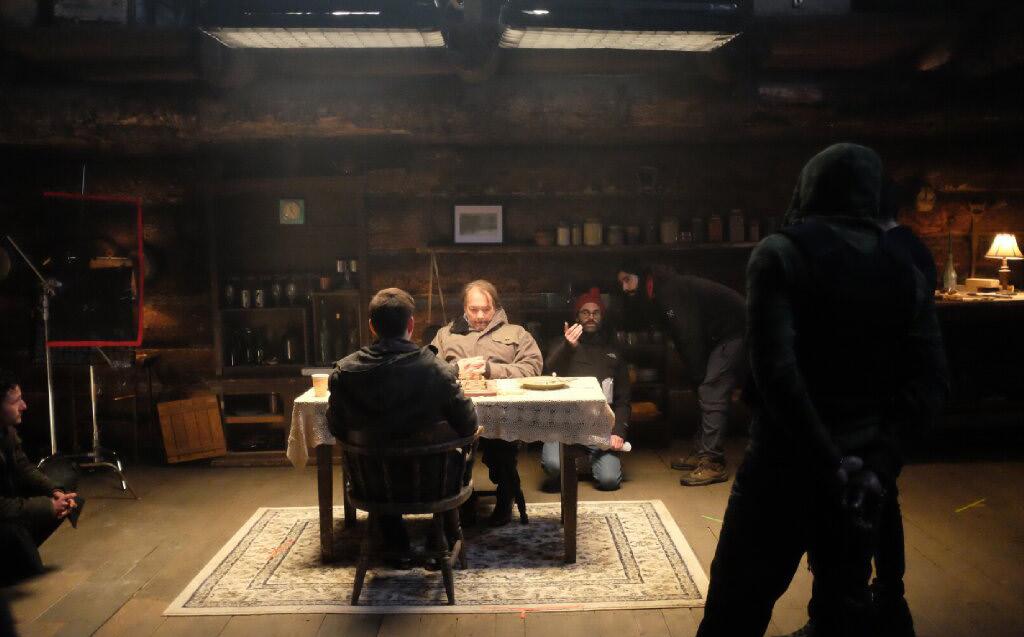
Jesse Moss and Philip Granger.
through windows and the door that set itself ajar. These scenes used an Arri M90 through the window placed at a distance that would give just the right fall-off. Through the smaller windows, M40s, M18s, a 1.8K par and 800w Jokers were employed to recreate shafts of light. I had asked the art department to build a gobo made of leftover wood from the cabin. This was placed on

the second level with our 800w Jokers so when we followed Jamie on the dolly as he approaches the door, the shafts would dance a little on top of frame and gave some life to the light. For the night interior scenes, the gantry overhead allowed rigging into the beams, so I was able to pepper light with small sources here and there using covered wagons, LED battens and small tungsten units. I could also hang
NIKON Z 6 FILMMAKER’S KIT $1,400 SAVINGS*

1 YEAR FREE SUBSCRIPTION
Amazing productions start here. Your video productions have evolved. More sophisticated. More ambitious. Your video gear needs to deliver on your vision without compromise. When you’re ready for your video content to rise above ordinary, the Z 6 Filmmaker’s Kit gives you the tools you need to step up your production in one convenient bundle. Smooth, steady and cinematic full-frame 4K Ultra HD. Compatible with a vast selection of stellar NIKKOR lens options. Flexible, external monitoring and recording. Smooth, clean audio. And all the key components to make your next video project stand out. Visit www.nikon.ca
Philip Granger as Sam.
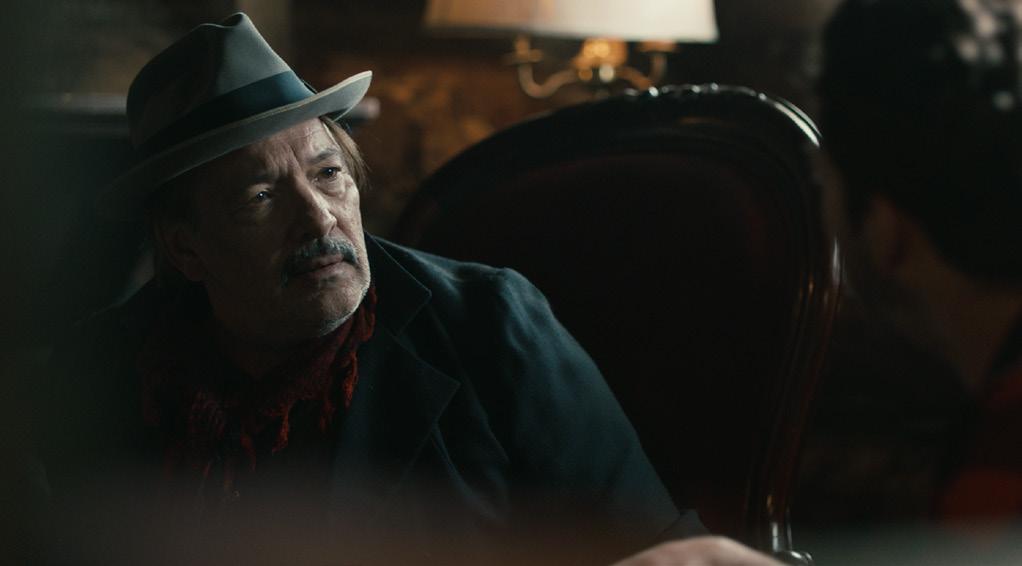
12x12 unbleached muslin overhead bringing in soft brushstrokes of warm tungsten light here and there, and introduce some of the moonlight effect into the scene. I did extensive testing for the moonlight look that would suit the tone of the script. We settled on Calcolour 15 and mixed it occasionally with Cyan 15, creating a desaturated moonlight look. A coffin box rigged overhead utilizing two S2 Litemat 4s created a theatrical look for younger Jamie and Sam, played by Phil Granger. My intention was that on a very subconscious level it would look like a play that present-day Jamie was watching.
CC: How did practicals come into play?
MW: There was a key moment of realization in Jamie that he was about to relive an emotionally poignant memory, and I wanted the lamp shade to be red to subtly undulate that moment as a foreboding visual cue. We were able to augment that practical with an RGB 4’ Quasar and further took that unit out of a fairly primary colour with a brown gel to match the rusty red of the lampshade. Corey fitted the practicals with 100w tungsten bulbs which were dimmed down to about 50 per cent which gave us the warmth needed to contrast the moonlight look of the night scenes. I knew we were able to isolate and play with the subtleties of warmth of the practicals further in the grade with colorist Sam Gilling.
CC: What challenges did you run into?
MW: The cabin required a lot of light to execute the look we were after and we used a large generator as there was no accessible power at the location. Unfortunately, early on in the shoot we experienced issues with the generator where the practicals appeared to be pulsing slowly. The idea of the light being reactive and having a consciousness was crucial to developing a presence to the cabin, so this happy accident actually was in keeping with the pulsating creepiness of the entity controlling the cabin. When we replaced the generator the next day, embracing that look was a no-brainer and we recreated it in key moments with inline dimmers. Staying open to those happy accidents is always a challenge with the velocity of the day but I’m really happy with embracing it and how it helped create the cabin as another character.
The Cooke Look ®
The Original Since 1894
Cooke S7I Full Frame Plus T2.0 Primes


Available in focal lengths: 16, 18, 21, 25, 27, 32, 40, 50, 60 MACRO, 65, 75, 90 MACRO, 100, 135, 150 MACRO, 180 and 300mm. PL or LPL mounts available.
“The Channel 9 HALIFAX: Retribution mini-series was set and shot in Melbourne. I wanted to maximise the fact that it was a city-based show and get the most out of the landscape. The premise of the story includes an unknown sniper who could be watching from anywhere, so for a cinematographer it had great visual scope with vast night time cityscapes and selective points of view. With lots of night and low light scenes I chose to shoot full frame to make the most of the Cooke T2 S7/i lenses capturing a true, big cinematic look with bokeh influence. I love the characteristics that are consistent across all the Cooke lenses. You get great colour rendition and unique, interesting focus characteristics – sharp but not harsh, and with the right focus drop off in full frame the images can be controlled to look painterly and create a fluidity of character with great depth.
www.cookeoptics.tv
www.shotoncooke.com I also like the physicality and mechanics of the lenses; you always get the same sort of focus roll, smooth, consistent movement throughout the range – my focus puller loves them! Professionally I find them to be an absolute asset.”

Geoffrey Hall, ACS Cinematographer, HALIFAX: Retribution
British Optical Innovation and Quality Since 1894.
cookeoptics.com T: +44 (0)116 264 0700 Cooke Americas cookeamericas.com T: +1-973-335-4460
By Tanya Lyon
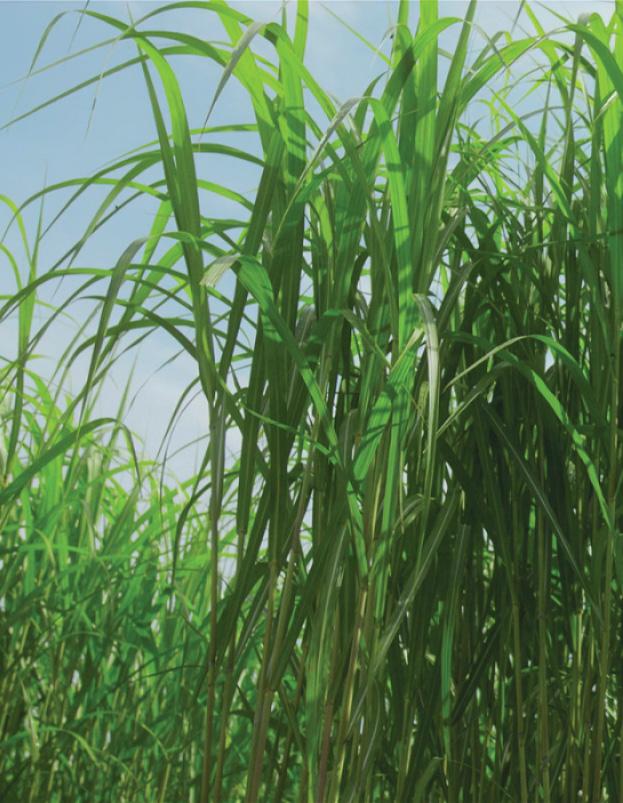
Credit: Courtesy Netflix A fter making a splash with the superhero series The Umbrella Academy, DP Craig Wrobleski csc returns to Netflix with In the Tall Grass. Based on the Stephen King and Joe Hill novella of the same name, In the Tall Grass is a supernatural horror directed by Vincenzo Natali. The film follows siblings Becky and Cal DeMuth as they investigate the cries of a lost boy in a field of tall grass. What follows is an immersive horror film, vivid with detail. ARRI caught up with Wrobleski to discuss everything from balancing the natural and supernatural, to his love of texture when capturing images.

(L-R) Patrick Wilson, Harrison Gilbertson, Laysla De Oliveira and Avery Whitted.

Did you have any visual inspiration or a specific style you were going for in capturing In the Tall Grass?
Well, the critical thing was that it had to be immersive. The audience had to feel that they were in the grass with the characters. We did discuss The Thin Red Line, a Terrence Malick film where the soldiers were fighting on a tropical island, dealing with visibility issues with the grass and not able to see the enemy, but we didn’t really have any specific visual references. Vincenzo, the director, had a Japanese anime artist do a lot of pre-viz work, so I would say that the look of the film is fairly unique in the sense that we didn’t specifically reference any other films. The whole look drew from this notion that it either had to be natural or supernatural. If we ended up in the middle ground where it’s stylized naturalism, it’s not going to work when we get supernatural and things get really crazy. So, that was the overriding mantra for me. It was just about feeling very natural and very real. The film definitely had an immersive feeling. You got a sense of being surrounded by that tall grass. So how did you go about achieving that?
That immersive quality was a big part of why I was pushing to shoot on a larger sensor. When I was approached, I was shooting The Umbrella Academy, which was shot on the ALEXA 65. The ALEXA 65 is unbeatable as a capture medium because it is so incredibly immersive and incredibly detailed. It picks out every single nuance of the image and has so much to offer. But the reality of taking the [ALEXA] 65 into the field was overwhelming for this production. I had previous experience with the ALEXA LF, and I thought it was a perfect fit. It offered that immersive quality and a larger sensor, which allowed us to shoot wide lenses but not “feel” the lenses as much. If we went in there with a conventionalsized [Super 35] sensor and shot with really wide lenses, you’d feel the lens and the grass bending on
Credit: Courtesy Netflix


Craig Wrobleski csc on the set of In The Tall Grass.
the edge of the frame. It would take some of that realism away. You’d start to feel you were in a supernatural world because it would have that fisheye look. The [ALEXA] LF was perfect for flattening the frame but still giving it that beautiful, wide perspective that made us feel like we were right in there with the characters.
Is that immersive feeling something that you feel large format film cameras provide versus their Super 35 counterpart?
Definitely. I always want my photography to support the story and I don’t want to feel like we are inflicting ourselves onto the story. Sometimes when you get into wide lenses, you start to feel the lens. The larger sensor captures all of the details, the nuances and the way the focus falls off is so beautiful. You can get these beautiful layers of texture in the grass.
That’s what the larger sensor helped with so that there were layers, and it was never just faces cut out against a mask of green. If we had a conventional sensor, we would’ve run the risk of everything feeling flat and one dimensional.
Can you talk about how much CG was involved?
I don’t want to give away the exact ratio of what’s real and what isn’t, but we did spend an enormous amount of time in real grass. The majority of the film is real grass. We shot exteriors in a field in Stratford, Ontario. We did move into a stage for the interior work. That was only because the reality of shooting night exteriors in a field in summer, would’ve made it even more uncomfortable for the actors and crew. Regardless of that, it is a truly challenging environment to work in. The grass is serrated, so it’s like a knife. So, when you walk in it, it will cut you. You can see it in the actors. In some of the early takes, you can see that the actors are visibly annoyed [by the grass.] You can see them walking





